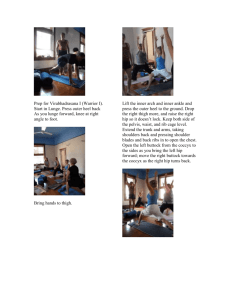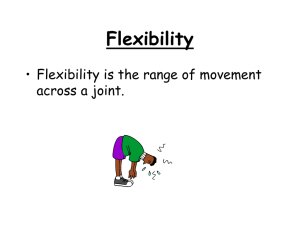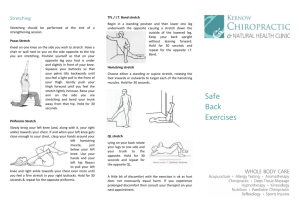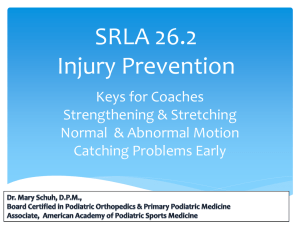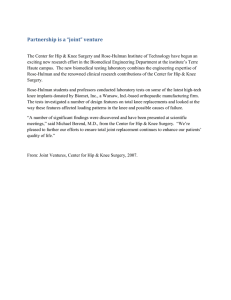8th lecture
advertisement
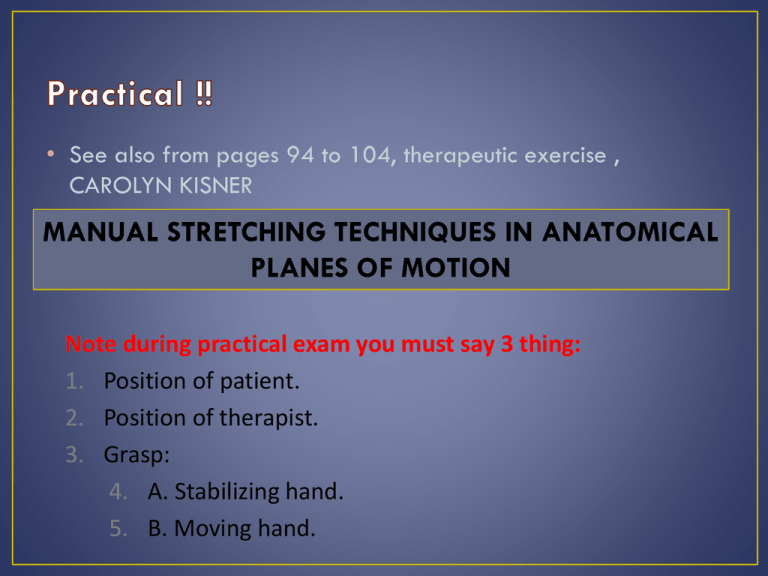
• See also from pages 94 to 104, therapeutic exercise , CAROLYN KISNER MANUAL STRETCHING TECHNIQUES IN ANATOMICAL PLANES OF MOTION Note during practical exam you must say 3 thing: 1. Position of patient. 2. Position of therapist. 3. Grasp: 4. A. Stabilizing hand. 5. B. Moving hand. • Stabilize the scapula • ROM is limited to only 120° . teres major latissimus dorsi • Adduction of the Shoulder • Rare thing to do • Perform bilateral Stretching as needed • Techniques should be performed with the forearm pronated as well as supinated • Hand Placement and Procedure • Grasp the distal forearm just proximal to the wrist. • With the arm at the patient's side supported on the table, stabilize the proximal humerus. • Flex the patient's elbow just past the point of tissue resistance to lengthen the elbow extensors. • To increase elbow flexion with the shoulder flexed • heterotopic ossification !! • the appearance of ectopic bone in the soft tissues around a joint due to vigorous, forcible passive stretching of the elbow flexors • Hand Placement and Procedure • humerus supported - elbow flexed 90° • grasp the distal forearm. • Stabilize the humerus. • Supinate or pronate the forearm just beyond the point of tissue resistance. • Do not twist the hand, thereby avoiding stress to the wrist articulations. • • • • Wrist Flexion Wrist Extension Radial Deviation Ulnar Deviation • CMC Joint of the Thumb • MCP Joints of the Digits • PIP and DIP Joints • to increase flexion of the hip with the knee flexed (stretch the gluteus maximus). • Hand Placement and Procedure • Flex the hip and knee simultaneously. • Stabilize the opposite femur in extension to prevent posterior tilt of the pelvis. • Move the patient's hip and knee into full flexion to lengthen the one-joint hip extensor. • Externally rotate the hip prior to hip flexion to isolate the stretch force to the medial hamstrings internally rotate the hip to isolate the stretch force to the lateral hamstrings. • Patient Position • Use either of the positions previously described for increasing hip extension in the supine or prone positions • Hand Placement and Procedure • With the hip held in full extension on the side to be stretched, move your hand to the distal tibia and gently flex the knee of that extremity as far as possible. • Do not allow the hip to abduct or rotate. • To increase adduction of the hip [stretch the tensor fasciae latae and iliotibial (IT) band] • Alternate Position and Procedure • Sitting at the edge of a table with hips and knees flexed to 90°. • Stabilize the pelvis by applying pressure to the iliac crest with one hand. • Apply the stretch force to the lateral malleolus or lateral aspect of the lower leg, and externally rotate the hip. • Alternate Position and Procedure • sitting with the thigh supported on the treatment table and leg flexed over the edge • Stabilize the anterior aspect of the proximal femur with one hand. • Apply the stretch force to the anterior aspect of the distal tibia and flex the patient's knee as far as possible. useful in the 0° to 100° range of knee flexion useful in the 90° to 135° range of knee flexion with the knee extended stretch the gastrocnemius with the knee flexed stretch the soleus Avoid placing too much pressure against the heads of the metatarsals • Hand Placement and Procedure • Support the posterior aspect of the distal tibia with one hand. • Grasp the foot along the tarsal and metatarsal areas. • Apply the stretch force to the anterior aspect of the foot, and plantarflex the foot as far as possible. • Hand Placement and Procedure • Stabilize the talus by grasping just distal to the malleoli with one hand. • Grasp the calcaneus with your other hand, and move it medially and laterally at the subtalar joint. • Hand Placement and Procedure • Stabilize the distal tibia with your proximal hand. • Grasp around the foot with your other hand and align the motion and force opposite the line of pull of the tendons. • Apply the stretch force against the bone to which the muscle attaches distally. tibialis anterior Grasp the dorsal aspect of the foot across the tarsals and metatarsals and plantarflex and abduct the foot. tibialis posterior Grasp the plantar surface of the foot around the tarsals and metatarsals and dorsiflex and abduct the foot. Peroneals Grasp the lateral aspect of the foot at the tarsals and metatarsals and invert the foot. • It is best to stretch any musculature that limits motion in the toes individually. • One hand, stabilize the bone proximal to the restricted joint, and with the other hand move the phalanx in the desired dire


